Minnesota Spiders
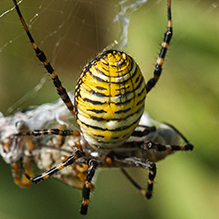
Order Araneae
Araneae (spiders) is the order of arachnids that is characterized by breathing air, having eight legs, and having chelicerae (mouth parts) with fangs that inject venom.
There are 43,678 known species in 3,705 genera in 109 families worldwide. There are about 3,400 species in North America and at least 466 species in Minnesota.
Recent Additions
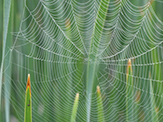
Araneidae is a large family of typical spiders known as orbweavers. It is the third largest family of spiders. There are 3,067 currently recognized orbweaver species in 177 genera worldwide, 180 species in North America north of Mexico, and at least 44 species in 16 genera in Minnesota.
Orbweavers are found in woodlands, fields, and caves; on grasses, shrubs, and trees; and on buildings and fences. They are best known for the circular webs, called orbs, that they build. The webs consist of a framework of non-sticky threads (spokes) extending from the edge to the middle, and concentric circles of sticky threads winding to the center.
Orbweavers are very diverse in size, shape, and color. They have eight small eyes in two rows. The lateral eyes are usually well separated from the median eyes. The median ocular area (MOA), the area defined by the middle four eyes, is in the shape of a trapezoid. The front part of the body (carapace) is smaller than the rear part (abdomen). The abdomen is large, rounded, and marked with lines, spots, or zig-zag patterns. The legs are short and spiny. The first and second pairs of legs project forward, the third and fourth pairs project backward. There are three claws at the end of each leg, though these are not visible without magnification. Females are much larger than males.

Dolomedes is a large species of nursery web spiders known as fishing spiders, raft spiders, dock spiders or wharf spiders. There are more than 100 currently recognized species worldwide, 8 species in North America north of Mexico. Four species have been recorded in Minnesota.
Fishing spiders have a worldwide distribution, occurring on every continent except Antarctica. They are usually found near permanent bodies of water, or on floating vegetation in a body of water. Some are found in grassy meadows. One, dark fishing spider, wanders well away from water. One, white-banded fishing spider, lives in trees. The remainder are semiaquatic, spending part of their time in or on water.
Some fishing spiders sit quietly at the edge of a lake or pond or on floating vegetation. They rest their front three pairs of legs on the water surface to detect ripples or vibrations of prey. Others stalk prey on land. They eat mostly aquatic insects but also small fish. None hunt from webs, but all make nursery webs for their young.
All fishing spiders are covered with water repelling (hydrophobic) hairs. They are able to run across the surface of the water and even to “climb” under the surface to subdue prey. When they submerge, air is trapped on the underside of their abdomen, and they are able to breath underwater.
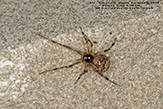
Common house spider (Parasteatoda tepidariorum) is the most common house spider in the eastern United States. It has a cosmopolitan distribution, occurring on every continent except Antarctica. In the United States it is common east of the Great Plains and west of the Rocky Mountains, uncommon between.
Common house spider is found in and around human dwellings, sheds, barns, and privies, in stables, under highway bridges, and in culverts. It appears year-round when indoors, but it cannot survive northern winters outdoors. Its web is often built in upper angles of rooms and in corners of window frames and doorways. It hunts at night, hanging upside-down in the middle of the web. During the day it retreats into a corner or a crack.
Common house spider is a medium-sized colorful comb-footed spider. The front part of the body is short, flat, highest in the middle, and yellowish-brown. The back part of the body is gray with white and dark markings. There is a dark horizontal line just before the highest point, white chevrons before the line, a white spot just behind the highest point, and dark chevrons behind the spot. On lighter individuals the markings are indistinct. On the male the abdomen is more slender. The legs are yellow with dark bands on the female, orangish on the male.
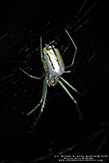
Orchard orbweaver (Leucauge venusta) is a sedentary, small, brilliantly colored, long-jawed orb weaver. It is one of the most common spiders in the eastern United States, but is less common in Minnesota, where it reaches the western extent of its range. It is found in forests, dense woodlands, woodland edges, shrubby meadows, gardens, and orchards.
The species name venusta is Latin for “beautiful” and it is easy to see why it was given to this spider. The abdomen is silvery-white with four pairs of dark stripes, a yellow stripe on each side, and often a pair of bright coppery-red spots toward the rear.
Charles Darwin collected this species in 1832 on his voyage of the Beagle. He named it Leucauge argyrobapta. Both names are from the Greek, Leucauge meaning “with a bright gleam,” and argyrobapta meaning “dipped in silver.” The specimen was lost after Darwin’s voyage back to London.
In 1973, as party of an experiment to study web building in zero gravity, two orchard weaver spiders were brought to the U.S. space station Skylab 3. After some time to adjust to weightlessness, the spiders constructed complete webs that were not much different than those constructed on earth.
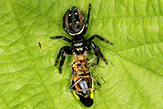
Brilliant jumping spider (Phidippus clarus) occurs across North America from coast to coast. It is very common in Minnesota. A study in 1997 surveyed jumping spiders in 30 locations around Minnesota. The author collected 572 jumping spiders representing 15 species. Brilliant jumping spider was by far the most common, with 299 specimens (52%) collected.
Brilliant jumping spider is found from July to September in moderately moist fields on grasses and perennial plants. It is a small to medium-sized spider (order Araneae) but a relatively large jumping spider (family Salticidae). Adults are mostly black with four pairs of white spots and two red stripes on the abdomen.
The female is a paragon of parental perseverance. In the fall she creates a large white egg sac at the top of a tall grass or herbaceous plant and drops eggs into the sac. She prevents the eggs from drying out by repeatedly adding silk to cover the egg mass. She stays with the egg sac until the young disperse in about a month. During this time she does not feed and usually dies from starvation a few days later.
Other Recent Additions
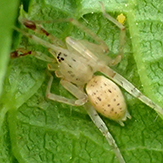
heptagonal orbweaver (Gea heptagon)
ghost spiders (Anyphaena spp.)
elongate stilt spider (Tetragnatha elongata)
leafcurling sac spiders (Clubiona spp.)
green-legged orbweaver (Mangora maculata)
long-legged ghost spider (Wulfila saltabundus)
This list includes only spiders that have been recorded in Minnesota, but not all of the spiders found in Minnesota.
| A | |||||
|---|---|---|---|---|---|
| Profile | Photo | Video | |||
Abbot’s sac spider (Clubiona abboti) |
|||||
American rockweaver (Titanoeca americana) |
|||||
angulate and roundshouldered orbweavers (Araneus spp.) |
|||||
ant running crab spider (Thanatus formicinus) |
|||||
ant sheet-web weaver (Tennesseellum formica) |
|||||
Apache jumping spider (Phidippus apacheanus) |
|||||
armoured antmimic corinne spider (Scotinella pugnata) |
|||||
arrowshaped micrathena (Micrathena sagittata) |
|||||
arrow-shaped orbweaver (Micrathena sagittata) |
|||||
attractive running crab spider (Rhysodromus histrio) |
|||||
atypical patterned money spider (Grammonota inornata) |
|||||
autumn money spider (Erigone autumnalis) |
| B | |||||
|---|---|---|---|---|---|
| Profile | Photo | Video | |||
banded running crab spider (Philodromus imbecillus) |
|||||
bank sac spider (Clubiona riparia) |
|||||
bare-kneed ornamented jumping spider (Habronattus captiosus) |
|||||
beautiful ornamented jumping spider (Habronattus decorus) |
|||||
Bennett’s laceweaver (Callobius bennetti) |
|||||
big-eyed thick-jawed spider (Pachygnatha autumnalis) |
|||||
black-bellied burrowing wolf spider (Geolycosa wrighti) |
|||||
black-tailed red sheetweaver (Florinda coccinea) |
|||||
blazed dwarf weaver (Erigone blaesa) |
|||||
bog ground hunter (Gnaphosa parvula) |
|||||
bog sheet-web weaver (Kaestneria pullata) |
|||||
boreal black-banded cobweaver (Rugathodes aurantius) |
|||||
boreal tufted jumping spider (Phidippus borealis) |
|||||
broad armoured money spider (Ceraticelus similis) |
|||||
brotherly ground crab spider (Xysticus fraternus) |
|||||
brown widow (Latrodectus geometricus) |
|||||
brownblack cobweb weaver (Crustulina sticta) |
|||||
brush-legged wolf spider (Schizocosa ocreata) |
|||||
burrowing wolf spider (Geolycosa missouriensis) |
|||||
|
|||||
|
|||||
|
|||||
|
|||||
|
| C | |||||
|---|---|---|---|---|---|
| Profile | Photo | Video | |||
Cameron's humble money spider (Tapinocyba cameroni) |
|
||||
Canada pirate wolf spider (Piratula canadensis) |
|||||
Canada sac spider (Clubiona canadensis) |
|||||
Canada sheetweb weaver (Bathyphantes canadensis) |
|||||
Cantrall’s wolf spider (Piratula cantralli) |
|||||
Carolina wolf spider (Hogna carolinensis) |
|||||
cellar spider (Pholcus manueli) |
|||||
Chippewan ground crab spider (Xysticus chippewa) |
|||||
coathook money spider (Soulgas corticarius) |
|||||
cobweb spider (Platnickina alabamensis) |
|||||
cobweb spider (Theridion dividuum) |
|||||
common eastern ray spider (Theridiosoma gemmosum) |
|||||
common high-browed cobweaver (Dipoena nigra) |
|||||
common hitchhiking ground spider (Drassyllus depressus) |
|||||
common leaf-beetle jumping spider (Sassacus papenhoei) |
|||||
common patterned ant-mimic ground spider (Sergiolus montanus) |
|||||
common pirate spider (Mimetus puritanus) |
|||||
common six-spotted cobweaver (Rugathodes sexpunctatus) |
|||||
common stretch spider (Tetragnatha extensa) |
|||||
common thread meshweaver (Dictyna major) |
|||||
confusing sac spider (Clubiona mixta) |
|||||
conifer sac spider (Clubiona trivialis) |
|||||
contrasted ground crab spider (Xysticus alboniger) |
|||||
contrasted long-jawed spider (Tetragnatha straminea) |
|||||
contrasting jumping spider (Euophrys monadnock) |
|||||
contrasting spurred woodland funnelweaver (Coras lamellosus) |
|||||
cosmopolitan bitubercled cobweaver (Theridula opulenta) |
|||||
crenated rugose money spider (Ceratinops crenatus) |
|||||
cryptic tufted jumping spider (Phidippus cryptus) |
| D | |||||
|---|---|---|---|---|---|
| Profile | Photo | Video | |||
dark-legged pirate wolf spider (Pirata montanus) |
|||||
dark-tipped pirate wolf spider (Pirata aspirans) |
|||||
dearmata long-jawed orbweaver (Tetragnatha dearmata) |
|||||
digitate erudite money spider (Walckenaeria digitata) |
|||||
disruptive fine sheetweaver (Lepthyphantes turbatrix) |
|||||
double-knobbed short-legged sheetweaver (Agyneta fabra) |
|||||
Dutton's running crab spider (Tibellus duttoni) |
|||||
dwarf antmimic corinne spider (Phrurotimpus alarius) |
|||||
dwarf ground long-jawed spider (Glenognatha foxi) |
|||||
dwarf spiders (Subfamily Erigoninae) |
| E | |||||
|---|---|---|---|---|---|
| Profile | Photo | Video | |||
eastern cave long-jawed spider (Meta ovalis) |
|||||
eastern running crab spider (Philodromus vulgaris) |
|||||
eastern spined meshweaver (Phantyna bicornis) |
|||||
eastern triangular cobweaver (Euryopis funebris) |
|||||
Emerton’s armoured money spider (Ceraticelus emertoni) |
|||||
Emerton’s crab spider (Xysticus emertoni) |
|||||
Emerton's bitubercled cobweaver (Theridula emertoni) |
|||||
ensign ground hunter (Haplodrassus signifer) |
|||||
Eugen’s orbweaver (Singa eugeni) |
|||||
expanded arboreal money spider (Ceratinopsis nigripalpis) |
|||||
|
| F | |||||
|---|---|---|---|---|---|
| Profile | Photo | Video | |||
|
|
|||||
feathered money spider (Collinsia plumosa) |
|||||
featherlegged orbweaver (Uloborus glomosus) |
|||||
fence long-legged cobweaver (Theridion murarium) |
|||||
fierce orbweaver (Araneus saevus) |
|||||
filmy dome spider (Neriene radiata) |
|||||
filthy leaflitter crab spider (Ozyptila conspurcata) |
|||||
fingered cobweaver (Hentziectypus globosus) |
|||||
Finsch’s patterned jumping spider (Attulus finschi) |
|||||
fishing spider (Dolomedes striatus) |
|||||
flared thread meshweaver (Dictyna coloradensis) |
|||||
flat-legged jumping spider (Sibianor aemulus) |
|||||
flea jumping spider (Naphrys pulex) |
|||||
flower jumping spider (Attulus floricola) |
|||||
forest wolf spider (Hogna frondicola) |
|||||
forest wolf spider (Pardosa xerampelina) |
|||||
four-lined slender jumping spider (Marpissa lineata) |
|||||
Fratris ground hunter (Zelotes fratris) |
|||||
furrow orbweaver (Larinioides cornutus) |
| G | |||||
|---|---|---|---|---|---|
| Profile | Photo | Video | |||
Gertsch’s antmimic ground spider (Micaria gertschi) |
|||||
glossy ant-spider (Micaria pulicaria) |
|||||
grassland white-cheeked jumping spider (Pelegrina arizonensis) |
|||||
Great Lakes pirate wolf spider (Pirata montanoides) |
|||||
greater ant-mimic corinne spider (Phrurotimpus borealis) |
|||||
green longjawed orbweaver (Tetragnatha viridis) |
|||||
green lynx spider (Peucetia viridans) |
|||||
Greenland wolf spider (Pardosa groenlandica) |
|||||
green-legged ornamented jumping spider (Habronattus viridipes) |
|||||
grey ground crab spider (Xysticus gulosus) |
|||||
ground crab spider (Xysticus acerbus) |
|||||
ground spider (Sergiolus tennesseensis) |
|||||
ground spider (Zelotes subterraneus) |
|||||
Guatemala long-jawed spider (Tetragnatha guatemalensis) |
|||||
|
|||||
|
|||||
|
|||||
|
|||||
|
|||||
|
|||||
|
|||||
|
| H | |||||
|---|---|---|---|---|---|
| Profile | Photo | Video | |||
hackled-banded dictynid spider (Emblyna annulipes) |
|
||||
hammer-jawed jumping spider (Zygoballus rufipes) |
|||||
Hentz’s lined jumping spider (Phlegra hentzi) |
|||||
Hentz’s preening ground spider (Zelotes hentzi) |
|||||
Hentz’s ribbon meshweaver (Emblyna hentzi) |
|||||
hooked immaculate cobweaver (Robertus eremophilus) |
|||||
hooked long-legged cobweaver (Theridion petraeum) |
|||||
hook-toothed money spider (Erigone dentosa) |
|||||
horned parasitic cobweaver (Neospintharus trigonum) |
|||||
household fine sheetweaver (Lepthyphantes leprosus) |
|||||
Hoy’s jumping spider (Evarcha hoyi) |
|||||
humped bog orbweaver (Araneus corticarius) |
|||||
humped trashline orbweaver (Cyclosa turbinata) |
| I | |||||
|---|---|---|---|---|---|
| Profile | Photo | Video | |||
|
|||||
|
| J | |||||
|---|---|---|---|---|---|
| Profile | Photo | Video | |||
Johnson’s sac spider (Clubiona johnsoni) |
|||||
jumping spider (Attinella concolor) |
|||||
jumping spider (Habronattus coecatus) |
|||||
jumping spider (Phidippus insignarius) |
|||||
jumping spider (Phidippus pius) |
|||||
jumping spider (Sitticus concolor) |
|||||
| K | |||||
|---|---|---|---|---|---|
| Profile | Photo | Video | |||
Kaston sac spider (Clubiona kastoni) |
|
||||
Keyserling’s orbweaver (Singa keyserlingi) |
|||||
Keyserling’s running crab spider (Philodromus keyserlingi) |
|||||
Kulczynski’s sac spider (Clubiona kulczynskii) |
| L | |||||
|---|---|---|---|---|---|
| Profile | Photo | Video | |||
labyrinth orbweaver (Metepeira labyrinthea) |
|
||||
lance wolf spider (Schizocosa avida) |
|||||
large-spined long-legged cobweaver (Theridion glaucescens) |
|||||
latticed sheet-web weaver (Neriene clathrata) |
|||||
leaf-backed long-jawed cobweaver (Enoplognatha caricis) |
|||||
lesser antmimic corinne spider (Phrurotimpus certus) |
|||||
lesser joyful armoured money spider (Ceraticelus laetabilis) |
|||||
lesser spurred woodland funnelweaver (Coras juvenilis) |
|||||
lineweaving spider (Emertongone montifer) |
|||||
little banded wolf spider (Pardosa modica) |
|||||
lizard spider (Rhomphaea fictilium) |
|||||
Long Island crevice ground spider (Sosticus insularis) |
|||||
long-bodied cellar spider (Pholcus phalangioides) |
|||||
long-palped ant-mimic sac spider (Castianeira longipalpa) |
|||||
long-spined ribbon meshweaver (Emblyna roscida) |
|||||
long-spined sheetweaver (Diplostyla concolor) |
|||||
long-toothed thread meshweaver (Dictyna foliacea) |
|||||
lyric cobweaver (Yunohamella lyrica) |
| M | |||||
|---|---|---|---|---|---|
| Profile | Photo | Video | |||
Mackenzie’s thin-legged wolf spider (Pardosa mackenziana) |
|
||||
Maddison’s jumping spider (Habronattus calcaratus maddisoni) |
|||||
Manitoba ribbon meshweaver (Emblyna manitoba) |
|||||
marbled cobweb spider (Enoplognatha marmorata) |
|||||
marbled purple jumping spider (Phidippus purpuratus) |
|||||
maritime running crab spider (Tibellus maritimus) |
|||||
marked sheet-web weaver (Helophora insignis) |
|||||
marsh orbweaver (Neoscona pratensis) |
|||||
McCook’s split wolf spider (Schizocosa mccooki) |
|||||
medicine spider (Coras medicinalis) |
|||||
Mediterranean spiny false wolf spider (Zoropsis spinimana) |
|||||
meshweavers (Dictyna spp.) |
|||||
midwestern antmimic corinne spider (Scotinella minnetonka) |
|||||
minute jumping spider (Talavera minuta) |
|||||
multicolored bark crab spider (Bassaniana versicolor) |
| N | |||||
|---|---|---|---|---|---|
| Profile | Photo | Video | |||
Nell’s tiny jumping spider (Neon nelli) |
|||||
nervous hammer-jawed jumping spider (Zygoballus nervosus) |
|||||
Nordmann’s orbweaver (Araneus nordmanni) |
|||||
northern black widow (Latrodectus variolus) |
|||||
northern spurred woodland funnelweaver (Coras montanus) |
|||||
notch-tipped shield sheetweaver (Bathyphantes alboventris) |
| O | |||||
|---|---|---|---|---|---|
| Profile | Photo | Video | |||
Oklahoma funnelweb spider(Agelenopsis oklahoma) |
|||||
orange orbweaver (Araneus iviei) |
|||||
ornate sheet-web weaver (Tmeticus ornatus) |
|||||
owl-faced dome sheetweaver (Neriene variabilis) |
|||||
|
|||||
|
|||||
|
|||||
|
| P | |||||
|---|---|---|---|---|---|
| Profile | Photo | Video | |||
painted cobweb weaver (Theridion pictum) |
|
||||
pale long-jawed spider (Tetragnatha pallescens) |
|||||
pale money spider (Scotinotylus pallidus) |
|||||
pale sheetweb weaver (Bathyphantes pallidus) |
|||||
pale thin-legged wolf spider (Pardosa distincta) |
|||||
pantropical huntsman spider (Heteropoda venatoria) |
|||||
peninsular running crab spider (Philodromus peninsulanus) |
|||||
Pike slender jumping spider (Marpissa pikei) |
|||||
pirate otter spider (Pirata piraticus) |
|||||
plump dictynid spider (Argenna obesa) |
|||||
Pluto ground hunter (Callilepis pluto) |
|||||
pointy-backed orbweaver (Cercidia prominens) |
|||||
post dwarf weaver (Erigone atra) |
|||||
puritan ground hunter (Zelotes puritanus) |
|||||
purplish stylus money spider (Styloctetor purpurescens) |
| Q | |||||
|---|---|---|---|---|---|
| Profile | Photo | Video | |||
|
|||||
|
| R | |||||
|---|---|---|---|---|---|
| Profile | Photo | Video | |||
rabid wolf spider (Rabidosa rabida) |
|
||||
rare ground crab spider (Xysticus fervidus) |
|||||
red-and-yellow running crab spider (Philodromus exilis) |
|||||
reddish running crab spider (Thanatus rubicellus) |
|||||
red-femured spotted orbweaver (Neoscona domiciliorum) |
|||||
redlined wolf spider (Arctosa rubicunda) |
|||||
red-spotted ant-mimic sac spider (Castianeira descripta) |
|||||
red-spotted orbweaver (Araneus cingulatus) |
|||||
resplendant running crab spider (Philodromus praelustris) |
|||||
riparian duncecap orbweaver (Eustala cepina) |
|||||
rubens orbweaver (Hypsosinga rubens) |
|||||
rustic wolf spider (Trochosa ruricola) |
| S | |||||
|---|---|---|---|---|---|
| Profile | Photo | Video | |||
saccate notched ground spider (Drassodes saccatus) |
|||||
saxatile thin-legged wolf spider (Pardosa saxatilis) |
|||||
scopulifer sheet-web weaver (Glyphesis scopulifer) |
|||||
shiny wolf spider (Pardosa moesta) |
|||||
shore spider (Pardosa milvina) |
|||||
shoreline wolf spider (Arctosa littoralis) |
|||||
short-bellied slender jumping spider (Marpissa formosa) |
|||||
short-heeled thread meshweaver (Dictyna brevitarsa) |
|||||
shortnosed sheet-web weaver (Diplocephalus subrostratus) |
|||||
silver longjawed orbweaver (Tetragnatha laboriosa) |
|||||
simple round-bulbed jumping spider (Pellenes peninsularis) |
|||||
simple sheet-web weaver (Tapinocyba simplex) |
|||||
sinuous erudite money spider (Walckenaeria tibialis) |
|||||
slender spiny-legged spider (Agroeca pratensis) |
|||||
slender-spined antmimic ground spider (Micaria longipes) |
|||||
small orbweaver (Hypsosinga pygmaea) |
|||||
snowbank wolf spider (Pardosa fuscula) |
|||||
spined antmimic jumping spider (Synageles noxiosus) |
|||||
spined micrathena (Micrathena gracilis) |
|||||
spiny-legged pirate wolf spider (Pirata sedentarius) |
|||||
spinyrib wolf spider (Alopecosa aculeata) |
|||||
spiraling sheet-web weaver (Walckenaeria spiralis) |
|||||
spotted cobweaver (Thymoites unimaculatus) |
|||||
spruce sheet-web weaver (Grammonota angusta) |
|||||
spurred sac spider (Clubiona maritima) |
|||||
stone spider (Pardosa lapidicina) |
|||||
striped big-eyed sheetweaver (Tapinopa bilineata) |
|||||
striped jumping spider (Attulus striatus) |
|||||
sunshine sheet-web weaver (Gonatium crassipalpum) |
|||||
|
|||||
|
|||||
|
|||||
|
|||||
|
| T | |||||
|---|---|---|---|---|---|
| Profile | Photo | Video | |||
taiga wolf spider (Pardosa hyperborea) |
|||||
tailed long-jawed orbweaver (Tetragnatha caudata) |
|||||
tan crab spider (Xysticus ferox) |
|||||
teethed dwarf weaver (Erigone dentigera) |
|||||
Texas ornamented jumping spider (Habronattus texanus) |
|||||
thick-hooked comb-tailed spider (Neoantistea magna) |
|||||
thin-hooked comb-tailed spider (Neoantistea agilis) |
|||||
threefront dwarf weaver (Baryphyma trifrons) |
|||||
three-lined ground jumping dpider (Ghelna canadensis) |
|||||
tiny thread meshweaver (Dictyna minuta) |
|||||
toothed slender jumping spider (Marpissa grata) |
|||||
triangle weaver (Hyptiotes cavatus) |
|||||
triangulate comb-foot (Steatoda triangulosa) |
|||||
trilobed sac spider (Clubiona obesa) |
|||||
tripod antmimic jumping spider (Synageles occidentalis) |
|||||
truncated thread meshweaver (Dictyna volucripes) |
|||||
twin wrangling money spider (Eridantes erigonoides) |
|||||
twisted ground crab spider (Xysticus luctans) |
|||||
twobanded antmimic (Castianeira cingulata) |
|||||
two-spotted cobweb spider (Asagena americana) |
|||||
typical orbweavers (Eustala spp.) |
| U | |||||
|---|---|---|---|---|---|
| Profile | Photo | Video | |||
unbanded wolf spider (Hogna baltimoriana) |
|
||||
unequal whiskered money spider (Islandiana flaveola) |
|||||
Utah crab spider (Bassaniana utahensis) |
|||||
Utah funnelweb spider (Agelenopsis utahana) |
| V | |||||
|---|---|---|---|---|---|
| Profile | Photo | Video | |||
variegated ground spider (Sergiolus capulatus) |
|||||
versicolor long-jawed orbweaver (Tetragnatha versicolor) |
| W | |||||
|---|---|---|---|---|---|
| Profile | Photo | Video | |||
wandering ground crab spider (Xysticus discursans) |
|
||||
wandering house cobweaver (Parasteatoda tabulata) |
|||||
western black widow (Latrodectus hesperus) |
|||||
wetland antmimic jumping spider (Paradamoetas fontanus) |
|||||
wetland giant wolf spider (Tigrosa helluo) |
|||||
Wheeler's thick-legged jumping spider (Admestina wheeleri) |
|||||
white long-legged cobweaver (Theridion albidum) |
|||||
white micrathena (Micrathena mitrata) |
|||||
white sac spider (Elaver excepta) |
|||||
white-banded jumping spider (Eris flava) |
|||||
white-lipped ornamented jumping spider (Habronattus cognatus) |
|||||
white-spotted false widow (Steatoda albomaculata) |
|||||
white-striped jumping spider (Tutelina formicaria) |
|||||
white-striped running crab spider (Philodromus rufus vibrans) |
|||||
Whitman’s jumping spider (Phidippus whitmani) |
|||||
wolf spider (Schizocosa crassipes) |
|||||
wolf spider (Tigrosa annexa) |
|||||
woodlouse hunter (Dysdera crocata) |
| X | |||||
|---|---|---|---|---|---|
| Profile | Photo | Video | |||
|
|||||
|
| Y | |||||
|---|---|---|---|---|---|
| Profile | Photo | Video | |||
yellowleg jumping spider (Pelegrina flavipes) |
|||||
|
| Z | |||||
|---|---|---|---|---|---|
| Profile | Photo | Video | |||
|
|||||
|
Acanthepeira stellata (starbellied orbweaver)
Admestina wheeleri (Wheeler's thick-legged jumping spider)
Agelenopsis oklahoma (Oklahoma funnelweb spider)
Agelenopsis potteri (Potter’s grass spider)
Agelenopsis spp. (grass spiders)
Agelenopsis utahana (Utah funnelweb spider)
Agroeca pratensis (slender spiny-legged spider)
Agyneta fabra (double-knobbed short-legged sheetweaver)
Alopecosa aculeata (spinyrib wolf spider)
Anyphaena pectorosa (eastern spurred ghost spider)
Anyphaena spp. (ghost spiders)
Araneus bicentenarius (giant lichen orbweaver)
Araneus cavaticus (barn spider)
Araneus cingulatus (red-spotted orbweaver)
Araneus corticarius (humped bog orbweaver)
Araneus diadematus (cross orbweaver)
Araneus gemmoides (cat-faced orbweaver)
Araneus iviei (orange orbweaver)
Araneus marmoreus (marbled orbweaver)
Araneus nordmanni (Nordmann’s orbweaver)
Araneus pratensis (openfield orbweaver)
Araneus saevus (fierce orbweaver)
Araneus spp. (angulate and roundshouldered orbweavers)
Araneus thaddeus (lattice orbweaver)
Araneus trifolium (shamrock orbweaver)
Araniella displicata (six-spotted orbweaver)
Arctosa littoralis (shoreline wolf spider)
Arctosa rubicunda (redlined wolf spider)
Argenna obesa (plump dictynid spider)
Argiope aurantia (black and yellow argiope)
Argiope trifasciata (banded argiope)
Asagena americana (two-spotted cobweb spider)
Attinella concolor (jumping spider)
Attulus fasciger (Asiatic wall jumping spider)
Attulus finschi (Finsch’s patterned jumping spider)
Attulus floricola (flower jumping spider)
Attulus striatus (striped jumping spider)
Baryphyma trifrons (threefront dwarf weaver)
Bassaniana utahensis (Utah crab spider)
Bassaniana versicolor (multicolored bark crab spider)
Bathyphantes alboventris (notch-tipped shield sheetweaver)
Bathyphantes canadensis (Canada sheetweb weaver)
Bathyphantes pallidus (pale sheetweb weaver)
Callilepis pluto (Pluto ground hunter)
Callobius bennetti (Bennett’s laceweaver)
Castianeira cingulata (twobanded antmimic)
Castianeira descripta (red-spotted ant-mimic sac spider)
Castianeira longipalpa (long-palped ant-mimic sac spider)
Ceraticelus emertoni (Emerton’s armoured money spider)
Ceraticelus fissiceps (bicolored armoured money spider)
Ceraticelus laetabilis (lesser joyful armoured money spider)
Ceraticelus similis (broad armoured money spider)
Ceratinops crenatus (crenated rugose money spider)
Ceratinopsis nigripalpis (expanded arboreal money spider)
Cercidia prominens (pointy-backed orbweaver)
Cheiracanthium mildei (northern yellow sac spider)
Clubiona abboti (Abbot’s sac spider)
Clubiona canadensis (Canada sac spider)
Clubiona johnsoni (Johnson’s sac spider)
Clubiona kastoni (Kaston sac spider)
Clubiona kulczynskii (Kulczynski’s sac spider)
Clubiona maritima (spurred sac spider)
Clubiona mixta (confusing sac spider)
Clubiona obesa (trilobed sac spider)
Clubiona riparia (bank sac spider)
Clubiona spp. (leafcurling sac spiders)
Clubiona trivialis (conifer sac spider)
Collinsia plumosa (feathered money spider)
Coras juvenilis (lesser spurred woodland funnelweaver)
Coras lamellosus (contrasting spurred woodland funnelweaver)
Coras medicinalis (medicine spider)
Coras montanus (northern spurred woodland funnelweaver)
Crustulina sticta (brownblack cobweb weaver)
Cyclosa conica (conical trashline orbweaver)
Cyclosa turbinata (humped trashline orbweaver)
Dictyna bostoniensis (Boston thread meshweaver)
Dictyna brevitarsa (short-heeled thread meshweaver)
Dictyna coloradensis (flared thread meshweaver)
Dictyna foliacea (long-toothed thread meshweaver)
Dictyna major (common thread meshweaver)
Dictyna minuta (tiny thread meshweaver)
Dictyna spp. (meshweavers)
Dictyna volucripes (truncated thread meshweaver)
Diplocephalus subrostratus (shortnosed sheet-web weaver)
Diplostyla concolor (long-spined sheetweaver)
Dipoena nigra (common high-browed cobweaver)
Dolomedes scriptus (striped fishing spider)
Dolomedes spp. (fishing spiders)
Dolomedes striatus (fishing spider)
Dolomedes tenebrosus (dark fishing spider)
Dolomedes triton (six-spotted fishing spider)
Drapetisca alteranda (northern long-toothed sheetweaver)
Drassodes saccatus (saccate notched ground spider)
Drassyllus depressus (common hitchhiking ground spider)
Dysdera crocata (woodlouse hunter)
Elaver excepta (white sac spider)
Emblyna annulipes (hackled-banded dictynid spider)
Emblyna hentzi (Hentz’s ribbon meshweaver)
Emblyna manitoba (Manitoba ribbon meshweaver)
Emblyna roscida (long-spined ribbon meshweaver)
Emblyna sublata (wide ribbon meshweaver)
Emertongone montifer (lineweaving spider)
Enoplognatha caricis (leaf-backed long-jawed cobweaver)
Enoplognatha marmorata (marbled cobweb spider)
Enoplognatha ovata (candy-striped spider)
Eridantes erigonoides (twin wrangling money spider)
Erigone atra (post dwarf weaver)
Erigone autumnalis (autumn money spider)
Erigone blaesa (blazed dwarf weaver)
Erigone dentigera (teethed dwarf weaver)
Erigone dentosa (hook-toothed money spider)
Erigoninae (dwarf spiders)
Eris flava (white-banded jumping spider)
Eris militaris (bronze jumping spider)
Euophrys monadnock (contrasting jumping spider)
Euryopis funebris (eastern triangular cobweaver)
Eustala anastera (humpbacked orbweaver)
Eustala cepina (riparian duncecap orbweaver)
Eustala spp. (typical orbweavers)
Evarcha hoyi (Hoy’s jumping spider)
Florinda coccinea (black-tailed red sheetweaver)
Gea heptagon (heptagonal orbweaver)
Geolycosa missouriensis (burrowing wolf spider)
Geolycosa wrighti (black-bellied burrowing wolf spider)
Ghelna canadensis (three-lined ground jumping dpider)
Gladicosa gulosa (drumming sword wolf spider)
Glenognatha foxi (dwarf ground long-jawed spider)
Glyphesis scopulifer (scopulifer sheet-web weaver)
Gnaphosa parvula (bog ground hunter)
Gonatium crassipalpum (sunshine sheet-web weaver)
Grammonota angusta (spruce sheet-web weaver)
Grammonota inornata (atypical patterned money spider)
Habronattus calcaratus maddisoni (Maddison’s jumping spider)
Habronattus captiosus (bare-kneed ornamented jumping spider)
Habronattus coecatus (jumping spider)
Habronattus cognatus (white-lipped ornamented jumping spider)
Habronattus decorus (beautiful ornamented jumping spider)
Habronattus texanus (Texas ornamented jumping spider)
Habronattus viridipes (green-legged ornamented jumping spider)
Haplodrassus signifer (ensign ground hunter)
Helophora insignis (marked sheet-web weaver)
Hentzia mitrata (white-jawed jumping spider)
Hentzia palmarum (common Hentz jumping spider)
Hentziectypus globosus (fingered cobweaver)
Herpyllus ecclesiasticus (eastern parson spider)
Heteropoda venatoria (pantropical huntsman spider)
Hibana gracilis (garden ghost spider)
Hogna baltimoriana (unbanded wolf spider)
Hogna carolinensis (Carolina wolf spider)
Hogna frondicola (forest wolf spider)
Hypselistes florens (peatland sheetweb weaver)
Hypsosinga pygmaea (small orbweaver)
Hypsosinga rubens (rubens orbweaver)
Hyptiotes cavatus (triangle weaver)
Islandiana flaveola (unequal whiskered money spider)
Kaestneria pullata (bog sheet-web weaver)
Larinia borealis (striped orbweaver)
Larinioides cornutus (furrow orbweaver)
Larinioides patagiatus (bordered orbweaver)
Larinioides sclopetarius (gray cross spider)
Latrodectus geometricus (brown widow)
Latrodectus hesperus (western black widow)
Latrodectus variolus (northern black widow)
Lepthyphantes leprosus (household fine sheetweaver)
Lepthyphantes turbatrix (disruptive fine sheetweaver)
Maevia inclemens (dimorphic jumper)
Mangora gibberosa (lined orbweaver)
Mangora maculata (green-legged orbweaver)
Mangora placida (tuftlegged orbweaver)
Marpissa formosa (short-bellied slender jumping spider)
Marpissa grata (toothed slender jumping spider)
Marpissa lineata (four-lined slender jumping spider)
Marpissa pikei (Pike slender jumping spider)
Mecaphesa asperata (northern crab spider)
Mecaphesa celer (swift crab spider)
Meta ovalis (eastern cave long-jawed spider)
Metepeira labyrinthea (labyrinth orbweaver)
Micaria gertschi (Gertsch’s antmimic ground spider)
Micaria longipes (slender-spined antmimic ground spider)
Micaria pulicaria (glossy ant-spider)
Micrathena gracilis (spined micrathena)
Micrathena mitrata (white micrathena)
Micrathena sagittata (arrowshaped micrathena)
Micrathena sagittata (arrow-shaped orbweaver)
Mimetus notius (reticulated pirate spider)
Mimetus puritanus (common pirate spider)
Misumena vatia (goldenrod crab spider)
Naphrys pulex (flea jumping spider)
Neoantistea agilis (thin-hooked comb-tailed spider)
Neoantistea magna (thick-hooked comb-tailed spider)
Neon nelli (Nell’s tiny jumping spider)
Neoscona arabesca (arabesque orbweaver)
Neoscona crucifera (spotted orbweaver)
Neoscona domiciliorum (red-femured spotted orbweaver)
Neoscona pratensis (marsh orbweaver)
Neospintharus trigonum (horned parasitic cobweaver)
Neriene clathrata (latticed sheet-web weaver)
Neriene radiata (filmy dome spider)
Neriene variabilis (owl-faced dome sheetweaver)
Oxyopes salticus (striped lynx spider)
Oxyopes scalaris (western lynx spider)
Ozyptila conspurcata (filthy leaflitter crab spider)
Pachygnatha autumnalis (big-eyed thick-jawed spider)
Paradamoetas fontanus (wetland antmimic jumping spider)
Parasteatoda tabulata (wandering house cobweaver)
Parasteatoda tepidariorum (common house spider)
Pardosa distincta (pale thin-legged wolf spider)
Pardosa fuscula (snowbank wolf spider)
Pardosa groenlandica (Greenland wolf spider)
Pardosa hyperborea (taiga wolf spider)
Pardosa lapidicina (stone spider)
Pardosa mackenziana (Mackenzie’s thin-legged wolf spider)
Pardosa milvina (shore spider)
Pardosa modica (little banded wolf spider)
Pardosa moesta (shiny wolf spider)
Pardosa saxatilis (saxatile thin-legged wolf spider)
Pardosa spp. (thin-legged wolf spiders)
Pardosa xerampelina (forest wolf spider)
Pelegrina arizonensis (grassland white-cheeked jumping spider)
Pelegrina flavipes (yellowleg jumping spider)
Pelegrina galathea (peppered jumping spider)
Pelegrina insignis (spotted white-cheeked jumping spider)
Pelegrina proterva (common white-cheeked jumping spider)
Pelegrina spp. (white-cheeked jumping spiders)
Pellenes peninsularis (simple round-bulbed jumping spider)
Peucetia viridans (green lynx spider)
Phantyna bicornis (eastern spined meshweaver)
Phidippus apacheanus (Apache jumping spider)
Phidippus borealis (boreal tufted jumping spider)
Phidippus clarus (brilliant jumping spider)
Phidippus cryptus (cryptic tufted jumping spider)
Phidippus insignarius (jumping spider)
Phidippus pius (jumping spider)
Phidippus princeps (grayish jumping spider)
Phidippus purpuratus (marbled purple jumping spider)
Phidippus spp. (jumping spiders)
Phidippus whitmani (Whitman’s jumping spider)
Philodromus cespitum (turf running spider)
Philodromus exilis (red-and-yellow running crab spider)
Philodromus imbecillus (banded running crab spider)
Philodromus keyserlingi (Keyserling’s running crab spider)
Philodromus peninsulanus (peninsular running crab spider)
Philodromus placidus (slow running crab spider)
Philodromus praelustris (resplendant running crab spider)
Philodromus rufus vibrans (white-striped running crab spider)
Philodromus spp. (running crab spiders)
Philodromus vulgaris (eastern running crab spider)
Phlegra hentzi (Hentz’s lined jumping spider)
Pholcus manueli (cellar spider)
Pholcus phalangioides (long-bodied cellar spider)
Phrurotimpus alarius (dwarf antmimic corinne spider)
Phrurotimpus borealis (greater ant-mimic corinne spider)
Phrurotimpus certus (lesser antmimic corinne spider)
Pirata aspirans (dark-tipped pirate wolf spider)
Pirata montanoides (Great Lakes pirate wolf spider)
Pirata montanus (dark-legged pirate wolf spider)
Pirata piraticus (pirate otter spider)
Pirata sedentarius (spiny-legged pirate wolf spider)
Piratula canadensis (Canada pirate wolf spider)
Piratula cantralli (Cantrall’s wolf spider)
Piratula minuta (small pirate wolf spider)
Pisaurina mira (American nursery web spider)
Pityohyphantes costatus annulipes (hammock spider)
Platnickina alabamensis (cobweb spider)
Rabidosa rabida (rabid wolf spider)
Rhomphaea fictilium (lizard spider)
Rhysodromus histrio (attractive running crab spider)
Robertus eremophilus (hooked immaculate cobweaver)
Rugathodes aurantius (boreal black-banded cobweaver)
Rugathodes sexpunctatus (common six-spotted cobweaver)
Salticus scenicus (zebra jumper)
Sassacus papenhoei (common leaf-beetle jumping spider)
Schizocosa avida (lance wolf spider)
Schizocosa crassipes (wolf spider)
Schizocosa mccooki (McCook’s split wolf spider)
Schizocosa ocreata (brush-legged wolf spider)
Scotinella minnetonka (midwestern antmimic corinne spider)
Scotinella pugnata (armoured antmimic corinne spider)
Scotinotylus pallidus (pale money spider)
Sergiolus capulatus (variegated ground spider)
Sergiolus montanus (common patterned ant-mimic ground spider)
Sergiolus tennesseensis (ground spider)
Sibianor aemulus (flat-legged jumping spider)
Singa eugeni (Eugen’s orbweaver)
Singa keyserlingi (Keyserling’s orbweaver)
Sitticus concolor (jumping spider)
Sosticus insularis (Long Island crevice ground spider)
Soulgas corticarius (coathook money spider)
Steatoda albomaculata (white-spotted false widow)
Steatoda borealis (boreal combfoot)
Steatoda grossa (false black widow)
Steatoda triangulosa (triangulate comb-foot)
Styloctetor purpurescens (purplish stylus money spider)
Synageles noxiosus (spined antmimic jumping spider)
Synageles occidentalis (tripod antmimic jumping spider)
Talavera minuta (minute jumping spider)
Tapinocyba cameroni (Cameron's humble money spider)
Tapinocyba simplex (simple sheet-web weaver)
Tapinopa bilineata (striped big-eyed sheetweaver)
Tegenaria domestica (barn funnel weaver)
Tennesseellum formica (ant sheet-web weaver)
Tetragnatha caudata (tailed long-jawed orbweaver)
Tetragnatha dearmata (dearmata long-jawed orbweaver)
Tetragnatha elongata (elongate stilt spider)
Tetragnatha extensa (common stretch spider)
Tetragnatha guatemalensis (Guatemala long-jawed spider)
Tetragnatha laboriosa (silver longjawed orbweaver)
Tetragnatha pallescens (pale long-jawed spider)
Tetragnatha spp. (stretch spiders)
Tetragnatha straminea (contrasted long-jawed spider)
Tetragnatha versicolor (versicolor long-jawed orbweaver)
Tetragnatha viridis (green longjawed orbweaver)
Thanatus formicinus (ant running crab spider)
Thanatus rubicellus (reddish running crab spider)
Theridion albidum (white long-legged cobweaver)
Theridion differens (different cobweb weaver)
Theridion dividuum (cobweb spider)
Theridion frondeum (eastern long-legged cobweaver)
Theridion glaucescens (large-spined long-legged cobweaver)
Theridion murarium (fence long-legged cobweaver)
Theridion petraeum (hooked long-legged cobweaver)
Theridion pictum (painted cobweb weaver)
Theridion spp. (typical cobweb spiders)
Theridiosoma gemmosum (common eastern ray spider)
Theridula emertoni (Emerton's bitubercled cobweaver)
Theridula opulenta (cosmopolitan bitubercled cobweaver)
Thymoites spp. (cobweb spiders)
Thymoites unimaculatus (spotted cobweaver)
Tibellus duttoni (Dutton's running crab spider)
Tibellus maritimus (maritime running crab spider)
Tibellus oblongus (oblong running spider)
Tibellus spp. (slender crab spiders)
Tigrosa annexa (wolf spider)
Tigrosa helluo (wetland giant wolf spider)
Titanoeca americana (American rockweaver)
Tmarus angulatus (tuberculated crab spider)
Tmeticus ornatus (ornate sheet-web weaver)
Trachelas tranquillus (broad-faced sac spider)
Trochosa ruricola (rustic wolf spider)
Trochosa terricola (ground wolf spider)
Tutelina elegans (thin-spined jumping spider)
Tutelina formicaria (white-striped jumping spider)
Tutelina harti (Hart’s jumping spider)
Uloborus glomosus (featherlegged orbweaver)
Walckenaeria digitata (digitate erudite money spider)
Walckenaeria spiralis (spiraling sheet-web weaver)
Walckenaeria tibialis (sinuous erudite money spider)
Xysticus acerbus (ground crab spider)
Xysticus alboniger (contrasted ground crab spider)
Xysticus auctificus (recumbent ground crab spider)
Xysticus chippewa (Chippewan ground crab spider)
Xysticus discursans (wandering ground crab spider)
Xysticus elegans (elegant crab spider)
Xysticus emertoni (Emerton’s crab spider)
Xysticus ferox (tan crab spider)
Xysticus fervidus (rare ground crab spider)
Xysticus fraternus (brotherly ground crab spider)
Xysticus gulosus (grey ground crab spider)
Xysticus luctans (twisted ground crab spider)
Xysticus punctatus (punctated ground crab spider)
Yunohamella lyrica (lyric cobweaver)
Zelotes fratris (Fratris ground hunter)
Zelotes hentzi (Hentz’s preening ground spider)
Zelotes puritanus (puritan ground hunter)
Zelotes subterraneus (ground spider)
Zoropsis spinimana (Mediterranean spiny false wolf spider)
Zygoballus nervosus (nervous hammer-jawed jumping spider)
Zygoballus rufipes (hammer-jawed jumping spider)
No Species Page Yet?
If you do not see a linked page for a species in the list at left you can still upload a photo or video or report a sighting for that species. Click on one of the buttons below and type in the common name and/or scientific name of the species in your photo, video, or sighting. A new page will be created for that species featuring your contribution.
These buttons not working for you?
Simply email us at info@MinnesotaSeasons.com.
Capitalization of Common Names
The 1997 version of Common Names of Insects and Related Organisms, published by the Entomological Society of America (ESA), contains only 9 spider species. Two of those are placed in the wrong family and four are unrecognized common names. The inadequate coverage of arachnids by the ICZN spurred the American Arachnological Society (AAS) to develop their own list, Common Names of Arachnids. While the ESA has no rule or guideline that addresses capitalization of common names, the AAS does. Capital letters should not be used unless 1) the name begins a sentence, then the first letter of the name should be capitalized; or 2) the common name begins with a proper name, and that proper name begins with a capital letter (place name or person’s last name). MinnesotaSeasons.com will adhere to the convention adopted by AAS.



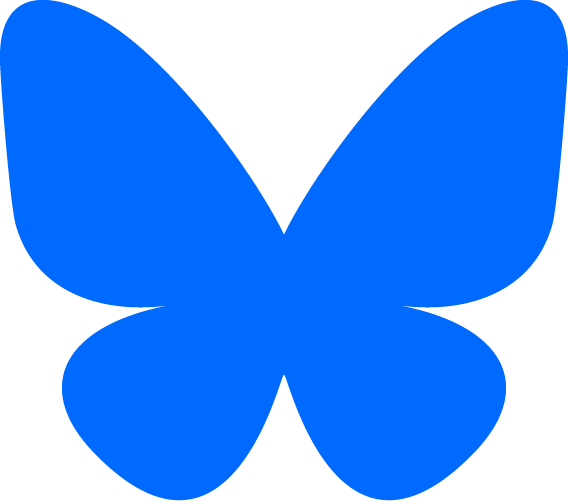




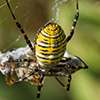















































_01t.jpg)




















































